University Project Management: BSC PM Case Scenario 2 Analysis
VerifiedAdded on 2022/08/16
|9
|1338
|12
Report
AI Summary
This report presents a detailed analysis of a project management case scenario, focusing on the 'Trip to Uganda' project. The core of the report is a comprehensive risk register, meticulously documenting key risks across financial, operational, schedule/time, and reputational categories. Each risk is assessed for its likelihood and impact, both before and after mitigation strategies are applied. The report outlines specific mitigation plans, contingency plans, and the status of each risk, providing a clear framework for managing potential issues. The second part of the report emphasizes the importance of a risk register within the overall risk management process, highlighting its role in identifying and documenting key risks, as well as in strategically planning project execution and ensuring project success. The report uses references to support the importance of risk management and the role of the risk register.

Running head: BSC PM
Case Scenario 2
Name of Student
Name of University
Author Note
Case Scenario 2
Name of Student
Name of University
Author Note
Paraphrase This Document
Need a fresh take? Get an instant paraphrase of this document with our AI Paraphraser

1
BSC PM
Table of Contents
1. Risk Register....................................................................................................................2
2. Importance of Risk Register in Overall Risk Management.............................................6
References............................................................................................................................8
BSC PM
Table of Contents
1. Risk Register....................................................................................................................2
2. Importance of Risk Register in Overall Risk Management.............................................6
References............................................................................................................................8
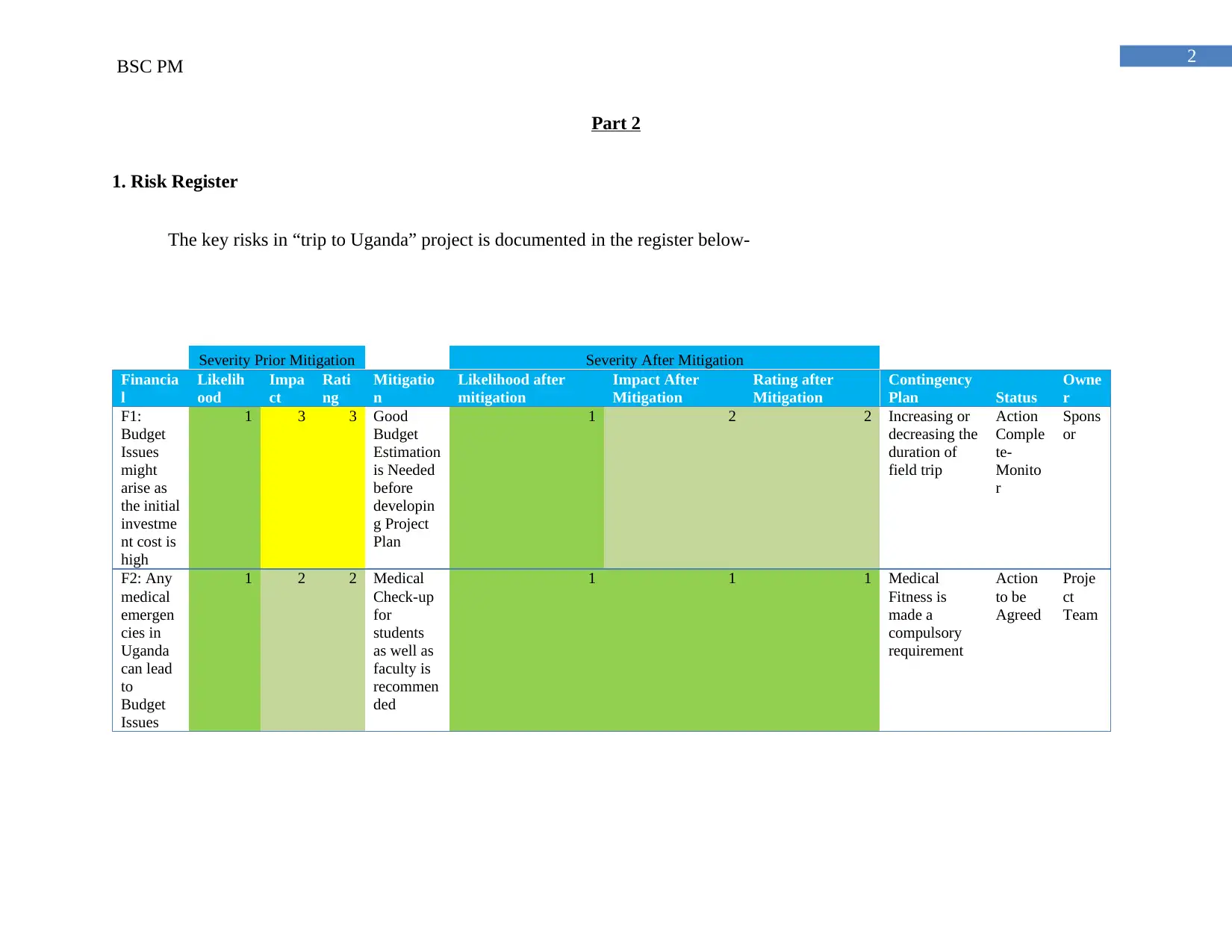
2
BSC PM
Part 2
1. Risk Register
The key risks in “trip to Uganda” project is documented in the register below-
Severity Prior Mitigation Severity After Mitigation
Financia
l
Likelih
ood
Impa
ct
Rati
ng
Mitigatio
n
Likelihood after
mitigation
Impact After
Mitigation
Rating after
Mitigation
Contingency
Plan Status
Owne
r
F1:
Budget
Issues
might
arise as
the initial
investme
nt cost is
high
1 3 3 Good
Budget
Estimation
is Needed
before
developin
g Project
Plan
1 2 2 Increasing or
decreasing the
duration of
field trip
Action
Comple
te-
Monito
r
Spons
or
F2: Any
medical
emergen
cies in
Uganda
can lead
to
Budget
Issues
1 2 2 Medical
Check-up
for
students
as well as
faculty is
recommen
ded
1 1 1 Medical
Fitness is
made a
compulsory
requirement
Action
to be
Agreed
Proje
ct
Team
BSC PM
Part 2
1. Risk Register
The key risks in “trip to Uganda” project is documented in the register below-
Severity Prior Mitigation Severity After Mitigation
Financia
l
Likelih
ood
Impa
ct
Rati
ng
Mitigatio
n
Likelihood after
mitigation
Impact After
Mitigation
Rating after
Mitigation
Contingency
Plan Status
Owne
r
F1:
Budget
Issues
might
arise as
the initial
investme
nt cost is
high
1 3 3 Good
Budget
Estimation
is Needed
before
developin
g Project
Plan
1 2 2 Increasing or
decreasing the
duration of
field trip
Action
Comple
te-
Monito
r
Spons
or
F2: Any
medical
emergen
cies in
Uganda
can lead
to
Budget
Issues
1 2 2 Medical
Check-up
for
students
as well as
faculty is
recommen
ded
1 1 1 Medical
Fitness is
made a
compulsory
requirement
Action
to be
Agreed
Proje
ct
Team
⊘ This is a preview!⊘
Do you want full access?
Subscribe today to unlock all pages.

Trusted by 1+ million students worldwide
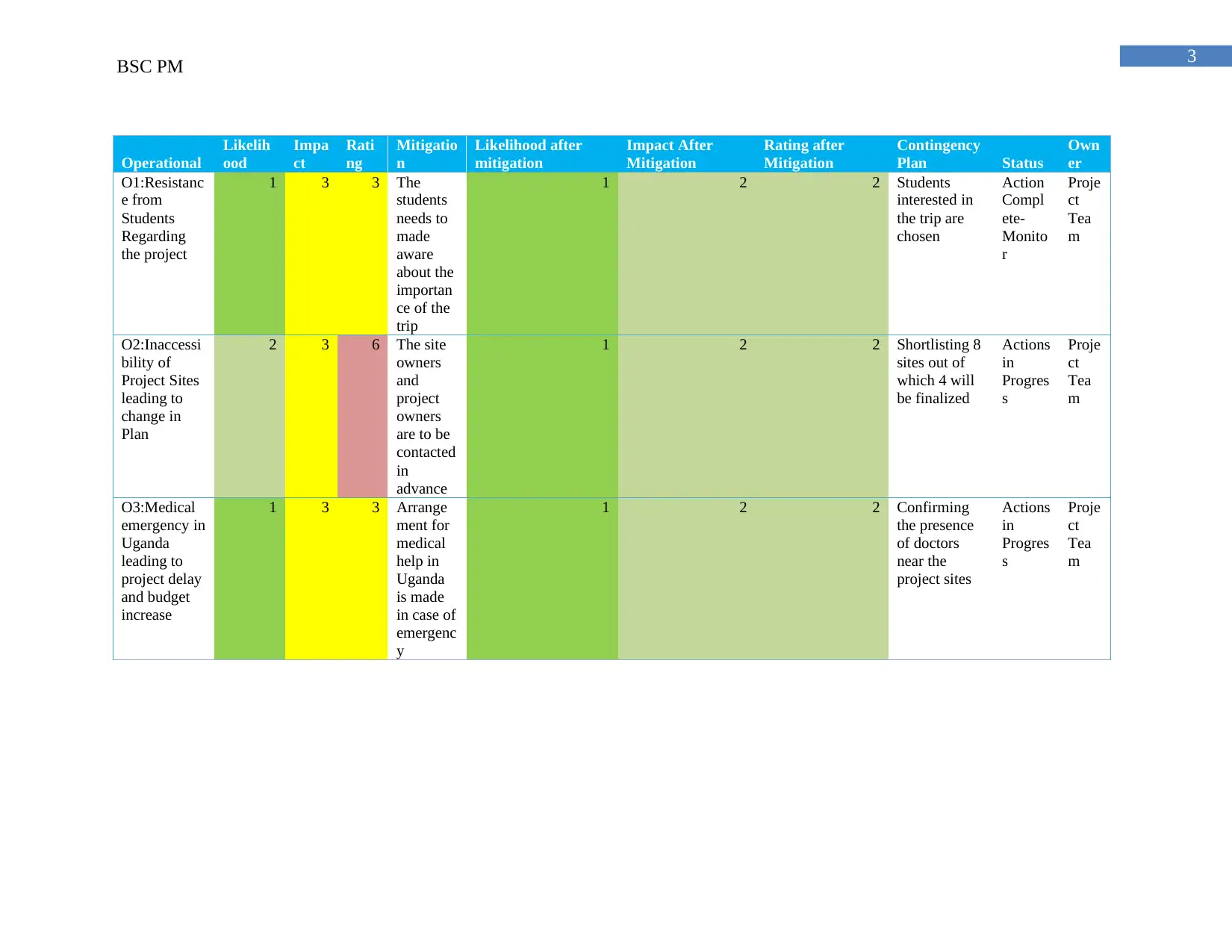
3
BSC PM
Operational
Likelih
ood
Impa
ct
Rati
ng
Mitigatio
n
Likelihood after
mitigation
Impact After
Mitigation
Rating after
Mitigation
Contingency
Plan Status
Own
er
O1:Resistanc
e from
Students
Regarding
the project
1 3 3 The
students
needs to
made
aware
about the
importan
ce of the
trip
1 2 2 Students
interested in
the trip are
chosen
Action
Compl
ete-
Monito
r
Proje
ct
Tea
m
O2:Inaccessi
bility of
Project Sites
leading to
change in
Plan
2 3 6 The site
owners
and
project
owners
are to be
contacted
in
advance
1 2 2 Shortlisting 8
sites out of
which 4 will
be finalized
Actions
in
Progres
s
Proje
ct
Tea
m
O3:Medical
emergency in
Uganda
leading to
project delay
and budget
increase
1 3 3 Arrange
ment for
medical
help in
Uganda
is made
in case of
emergenc
y
1 2 2 Confirming
the presence
of doctors
near the
project sites
Actions
in
Progres
s
Proje
ct
Tea
m
BSC PM
Operational
Likelih
ood
Impa
ct
Rati
ng
Mitigatio
n
Likelihood after
mitigation
Impact After
Mitigation
Rating after
Mitigation
Contingency
Plan Status
Own
er
O1:Resistanc
e from
Students
Regarding
the project
1 3 3 The
students
needs to
made
aware
about the
importan
ce of the
trip
1 2 2 Students
interested in
the trip are
chosen
Action
Compl
ete-
Monito
r
Proje
ct
Tea
m
O2:Inaccessi
bility of
Project Sites
leading to
change in
Plan
2 3 6 The site
owners
and
project
owners
are to be
contacted
in
advance
1 2 2 Shortlisting 8
sites out of
which 4 will
be finalized
Actions
in
Progres
s
Proje
ct
Tea
m
O3:Medical
emergency in
Uganda
leading to
project delay
and budget
increase
1 3 3 Arrange
ment for
medical
help in
Uganda
is made
in case of
emergenc
y
1 2 2 Confirming
the presence
of doctors
near the
project sites
Actions
in
Progres
s
Proje
ct
Tea
m
Paraphrase This Document
Need a fresh take? Get an instant paraphrase of this document with our AI Paraphraser

4
BSC PM
Schedule/
Time
Likelih
ood
Impa
ct
Rati
ng
Mitigati
on
Likelihood after
mitigation
Impact After
Mitigation
Rating after
Mitigation
Contingency
Plan Status
Owne
r
S1:
Ineffective
Planning
leading to
Schedule
Issues
2 3 6
The
project
Plan is
prepared
by
evaluatin
g the
major
risks 1 2 3
Each task is
scheduled by
allocating
maximum
time
Action
Comple
te-
Monito
r
Projec
t
Mana
ger
S2: Bad
Weather
delaying
the trip
2 2 4
The
project
is
schedule
d in
favourab
le
weather
conditio
n 1 2 2
Ensuring that
the
scheduling is
done in
favourable
condition
Closed Projec
t
Team
S3:
Ineffective
Team
delaying
project
Execution
2 2 4
An
experien
ced team
is
chosen
for the
project 1 2 2
Keeping a
backup team
in case any
issue arises
Action
Comple
te-
Monito
r
Projec
t
Team
BSC PM
Schedule/
Time
Likelih
ood
Impa
ct
Rati
ng
Mitigati
on
Likelihood after
mitigation
Impact After
Mitigation
Rating after
Mitigation
Contingency
Plan Status
Owne
r
S1:
Ineffective
Planning
leading to
Schedule
Issues
2 3 6
The
project
Plan is
prepared
by
evaluatin
g the
major
risks 1 2 3
Each task is
scheduled by
allocating
maximum
time
Action
Comple
te-
Monito
r
Projec
t
Mana
ger
S2: Bad
Weather
delaying
the trip
2 2 4
The
project
is
schedule
d in
favourab
le
weather
conditio
n 1 2 2
Ensuring that
the
scheduling is
done in
favourable
condition
Closed Projec
t
Team
S3:
Ineffective
Team
delaying
project
Execution
2 2 4
An
experien
ced team
is
chosen
for the
project 1 2 2
Keeping a
backup team
in case any
issue arises
Action
Comple
te-
Monito
r
Projec
t
Team

5
BSC PM
Reputational
Risk
Likelih
ood
Imp
act
Rati
ng
Mitigat
ion
Likelihood after
mitigation
Impact After
Mitigation
Rating after
Mitigation
Contingency
Plan
Stat
us Owner
R1: Failure of
the Project
will
negatively
impact the
reputation of
QAHE
2 3 6 The
Project
plan
should
be
prepare
d
efficient
ly to
ensure
project
success
1 1 1 Plan similar
projects more
effectively in
future
New Business
Manage
ment
Faculty
R2: Any
Negative
Result will
affect the
performance
and marks of
the students
chosen for the
trip
1 3 3 The
students
are
chosen
on basis
of their
experie
nce and
interest
for the
trip
1 2 2 Feedback
from the
student can
be taken
before
arranging
similar
projects
New Business
Manage
ment
Faculty
BSC PM
Reputational
Risk
Likelih
ood
Imp
act
Rati
ng
Mitigat
ion
Likelihood after
mitigation
Impact After
Mitigation
Rating after
Mitigation
Contingency
Plan
Stat
us Owner
R1: Failure of
the Project
will
negatively
impact the
reputation of
QAHE
2 3 6 The
Project
plan
should
be
prepare
d
efficient
ly to
ensure
project
success
1 1 1 Plan similar
projects more
effectively in
future
New Business
Manage
ment
Faculty
R2: Any
Negative
Result will
affect the
performance
and marks of
the students
chosen for the
trip
1 3 3 The
students
are
chosen
on basis
of their
experie
nce and
interest
for the
trip
1 2 2 Feedback
from the
student can
be taken
before
arranging
similar
projects
New Business
Manage
ment
Faculty
⊘ This is a preview!⊘
Do you want full access?
Subscribe today to unlock all pages.

Trusted by 1+ million students worldwide
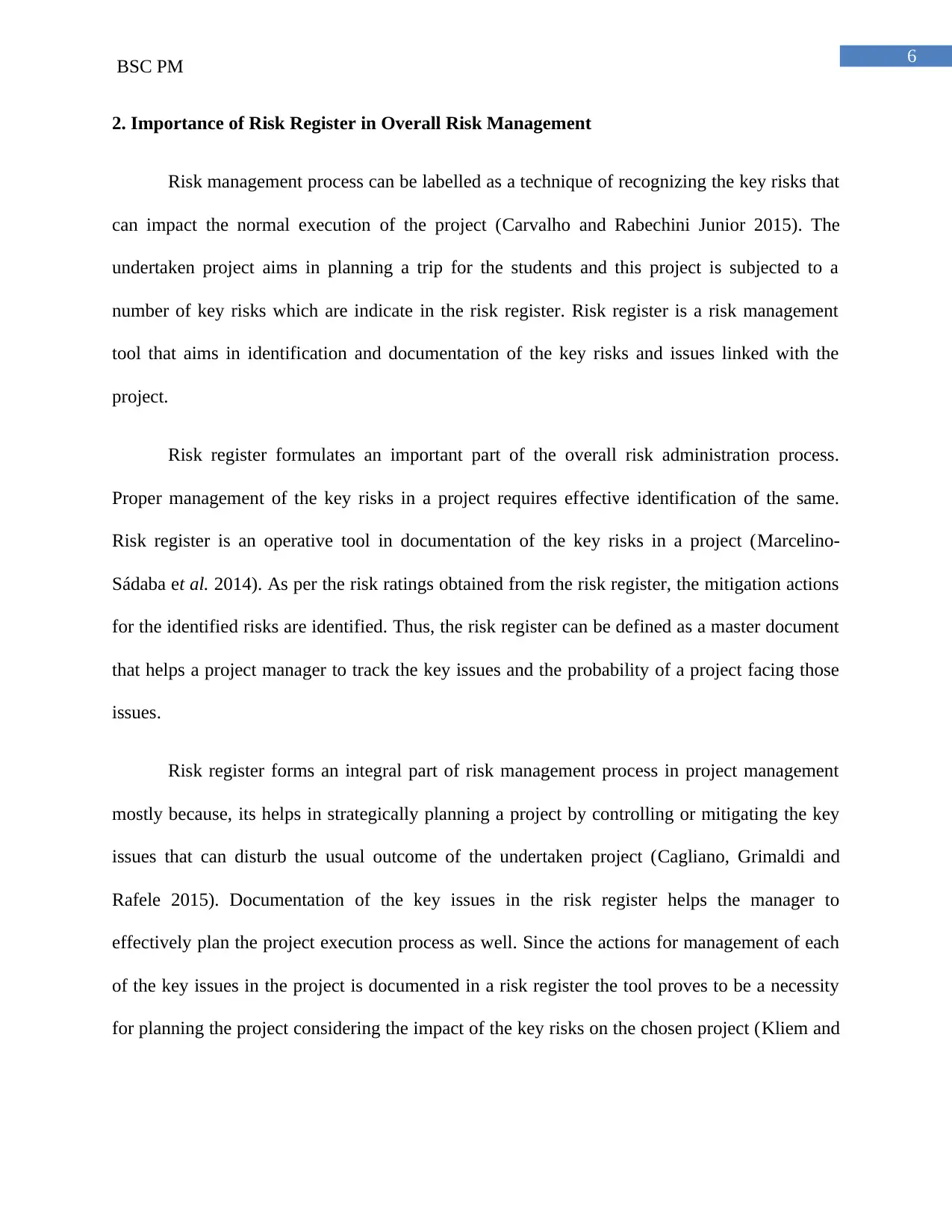
6
BSC PM
2. Importance of Risk Register in Overall Risk Management
Risk management process can be labelled as a technique of recognizing the key risks that
can impact the normal execution of the project (Carvalho and Rabechini Junior 2015). The
undertaken project aims in planning a trip for the students and this project is subjected to a
number of key risks which are indicate in the risk register. Risk register is a risk management
tool that aims in identification and documentation of the key risks and issues linked with the
project.
Risk register formulates an important part of the overall risk administration process.
Proper management of the key risks in a project requires effective identification of the same.
Risk register is an operative tool in documentation of the key risks in a project (Marcelino-
Sádaba et al. 2014). As per the risk ratings obtained from the risk register, the mitigation actions
for the identified risks are identified. Thus, the risk register can be defined as a master document
that helps a project manager to track the key issues and the probability of a project facing those
issues.
Risk register forms an integral part of risk management process in project management
mostly because, its helps in strategically planning a project by controlling or mitigating the key
issues that can disturb the usual outcome of the undertaken project (Cagliano, Grimaldi and
Rafele 2015). Documentation of the key issues in the risk register helps the manager to
effectively plan the project execution process as well. Since the actions for management of each
of the key issues in the project is documented in a risk register the tool proves to be a necessity
for planning the project considering the impact of the key risks on the chosen project (Kliem and
BSC PM
2. Importance of Risk Register in Overall Risk Management
Risk management process can be labelled as a technique of recognizing the key risks that
can impact the normal execution of the project (Carvalho and Rabechini Junior 2015). The
undertaken project aims in planning a trip for the students and this project is subjected to a
number of key risks which are indicate in the risk register. Risk register is a risk management
tool that aims in identification and documentation of the key risks and issues linked with the
project.
Risk register formulates an important part of the overall risk administration process.
Proper management of the key risks in a project requires effective identification of the same.
Risk register is an operative tool in documentation of the key risks in a project (Marcelino-
Sádaba et al. 2014). As per the risk ratings obtained from the risk register, the mitigation actions
for the identified risks are identified. Thus, the risk register can be defined as a master document
that helps a project manager to track the key issues and the probability of a project facing those
issues.
Risk register forms an integral part of risk management process in project management
mostly because, its helps in strategically planning a project by controlling or mitigating the key
issues that can disturb the usual outcome of the undertaken project (Cagliano, Grimaldi and
Rafele 2015). Documentation of the key issues in the risk register helps the manager to
effectively plan the project execution process as well. Since the actions for management of each
of the key issues in the project is documented in a risk register the tool proves to be a necessity
for planning the project considering the impact of the key risks on the chosen project (Kliem and
Paraphrase This Document
Need a fresh take? Get an instant paraphrase of this document with our AI Paraphraser
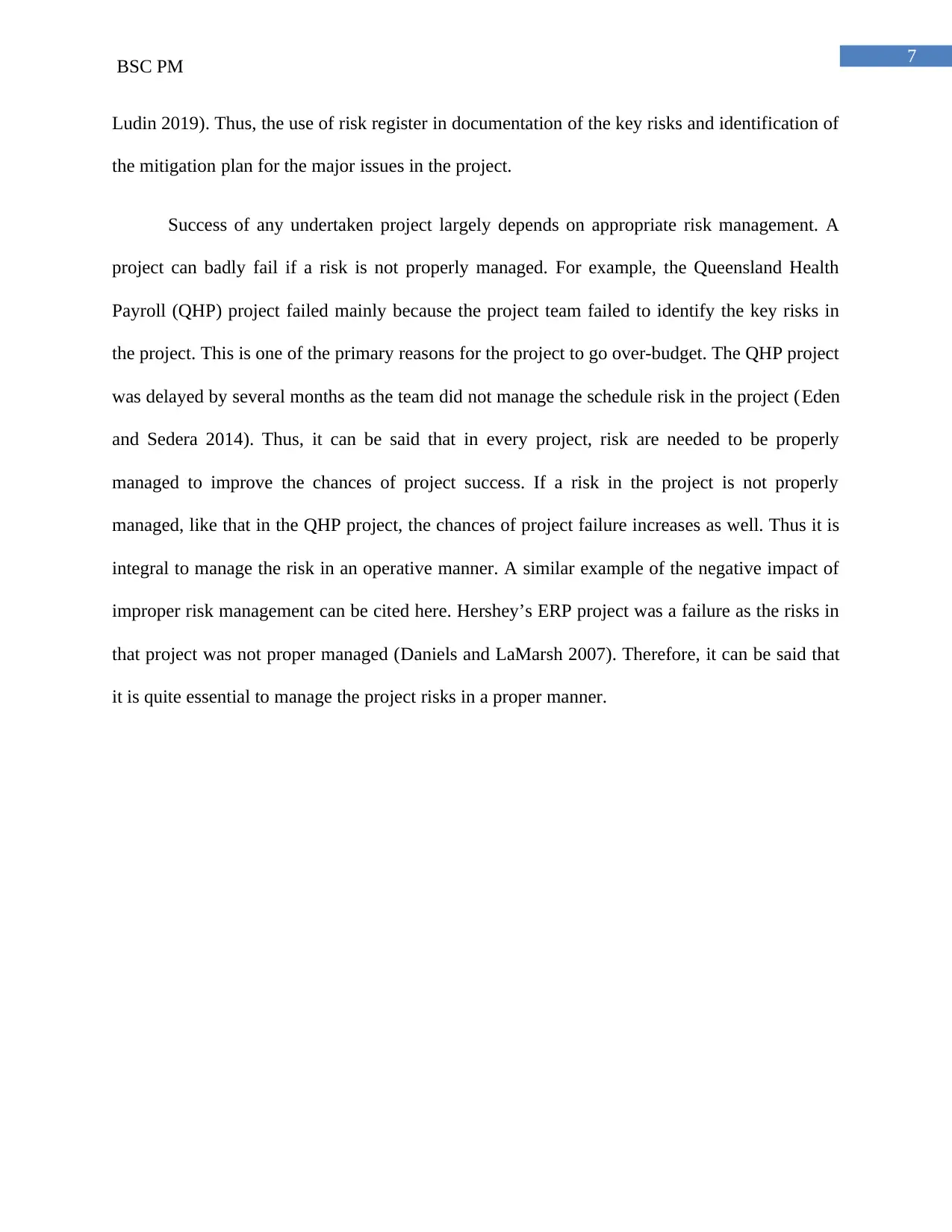
7
BSC PM
Ludin 2019). Thus, the use of risk register in documentation of the key risks and identification of
the mitigation plan for the major issues in the project.
Success of any undertaken project largely depends on appropriate risk management. A
project can badly fail if a risk is not properly managed. For example, the Queensland Health
Payroll (QHP) project failed mainly because the project team failed to identify the key risks in
the project. This is one of the primary reasons for the project to go over-budget. The QHP project
was delayed by several months as the team did not manage the schedule risk in the project (Eden
and Sedera 2014). Thus, it can be said that in every project, risk are needed to be properly
managed to improve the chances of project success. If a risk in the project is not properly
managed, like that in the QHP project, the chances of project failure increases as well. Thus it is
integral to manage the risk in an operative manner. A similar example of the negative impact of
improper risk management can be cited here. Hershey’s ERP project was a failure as the risks in
that project was not proper managed (Daniels and LaMarsh 2007). Therefore, it can be said that
it is quite essential to manage the project risks in a proper manner.
BSC PM
Ludin 2019). Thus, the use of risk register in documentation of the key risks and identification of
the mitigation plan for the major issues in the project.
Success of any undertaken project largely depends on appropriate risk management. A
project can badly fail if a risk is not properly managed. For example, the Queensland Health
Payroll (QHP) project failed mainly because the project team failed to identify the key risks in
the project. This is one of the primary reasons for the project to go over-budget. The QHP project
was delayed by several months as the team did not manage the schedule risk in the project (Eden
and Sedera 2014). Thus, it can be said that in every project, risk are needed to be properly
managed to improve the chances of project success. If a risk in the project is not properly
managed, like that in the QHP project, the chances of project failure increases as well. Thus it is
integral to manage the risk in an operative manner. A similar example of the negative impact of
improper risk management can be cited here. Hershey’s ERP project was a failure as the risks in
that project was not proper managed (Daniels and LaMarsh 2007). Therefore, it can be said that
it is quite essential to manage the project risks in a proper manner.
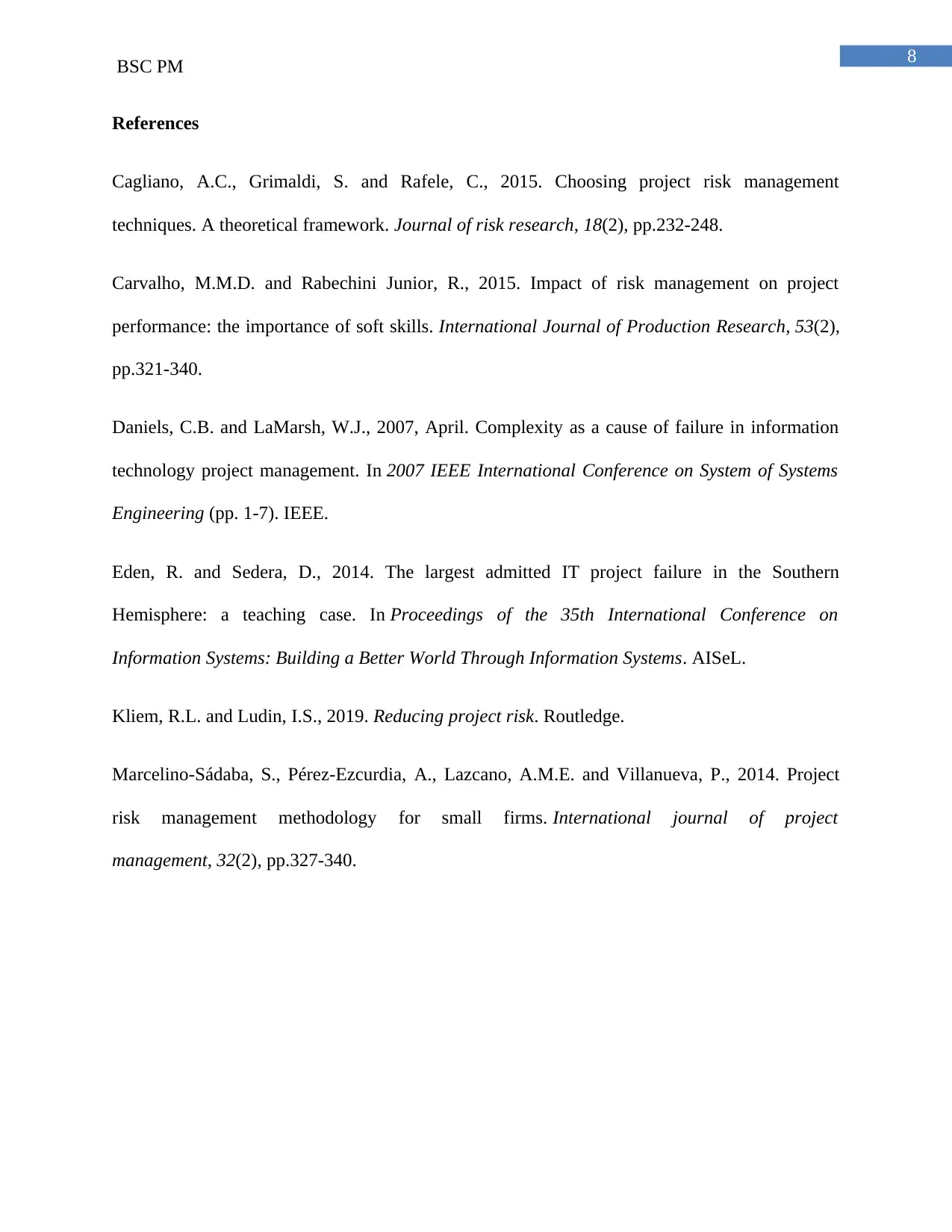
8
BSC PM
References
Cagliano, A.C., Grimaldi, S. and Rafele, C., 2015. Choosing project risk management
techniques. A theoretical framework. Journal of risk research, 18(2), pp.232-248.
Carvalho, M.M.D. and Rabechini Junior, R., 2015. Impact of risk management on project
performance: the importance of soft skills. International Journal of Production Research, 53(2),
pp.321-340.
Daniels, C.B. and LaMarsh, W.J., 2007, April. Complexity as a cause of failure in information
technology project management. In 2007 IEEE International Conference on System of Systems
Engineering (pp. 1-7). IEEE.
Eden, R. and Sedera, D., 2014. The largest admitted IT project failure in the Southern
Hemisphere: a teaching case. In Proceedings of the 35th International Conference on
Information Systems: Building a Better World Through Information Systems. AISeL.
Kliem, R.L. and Ludin, I.S., 2019. Reducing project risk. Routledge.
Marcelino-Sádaba, S., Pérez-Ezcurdia, A., Lazcano, A.M.E. and Villanueva, P., 2014. Project
risk management methodology for small firms. International journal of project
management, 32(2), pp.327-340.
BSC PM
References
Cagliano, A.C., Grimaldi, S. and Rafele, C., 2015. Choosing project risk management
techniques. A theoretical framework. Journal of risk research, 18(2), pp.232-248.
Carvalho, M.M.D. and Rabechini Junior, R., 2015. Impact of risk management on project
performance: the importance of soft skills. International Journal of Production Research, 53(2),
pp.321-340.
Daniels, C.B. and LaMarsh, W.J., 2007, April. Complexity as a cause of failure in information
technology project management. In 2007 IEEE International Conference on System of Systems
Engineering (pp. 1-7). IEEE.
Eden, R. and Sedera, D., 2014. The largest admitted IT project failure in the Southern
Hemisphere: a teaching case. In Proceedings of the 35th International Conference on
Information Systems: Building a Better World Through Information Systems. AISeL.
Kliem, R.L. and Ludin, I.S., 2019. Reducing project risk. Routledge.
Marcelino-Sádaba, S., Pérez-Ezcurdia, A., Lazcano, A.M.E. and Villanueva, P., 2014. Project
risk management methodology for small firms. International journal of project
management, 32(2), pp.327-340.
⊘ This is a preview!⊘
Do you want full access?
Subscribe today to unlock all pages.

Trusted by 1+ million students worldwide
1 out of 9
Related Documents
Your All-in-One AI-Powered Toolkit for Academic Success.
+13062052269
info@desklib.com
Available 24*7 on WhatsApp / Email
![[object Object]](/_next/static/media/star-bottom.7253800d.svg)
Unlock your academic potential
Copyright © 2020–2025 A2Z Services. All Rights Reserved. Developed and managed by ZUCOL.





